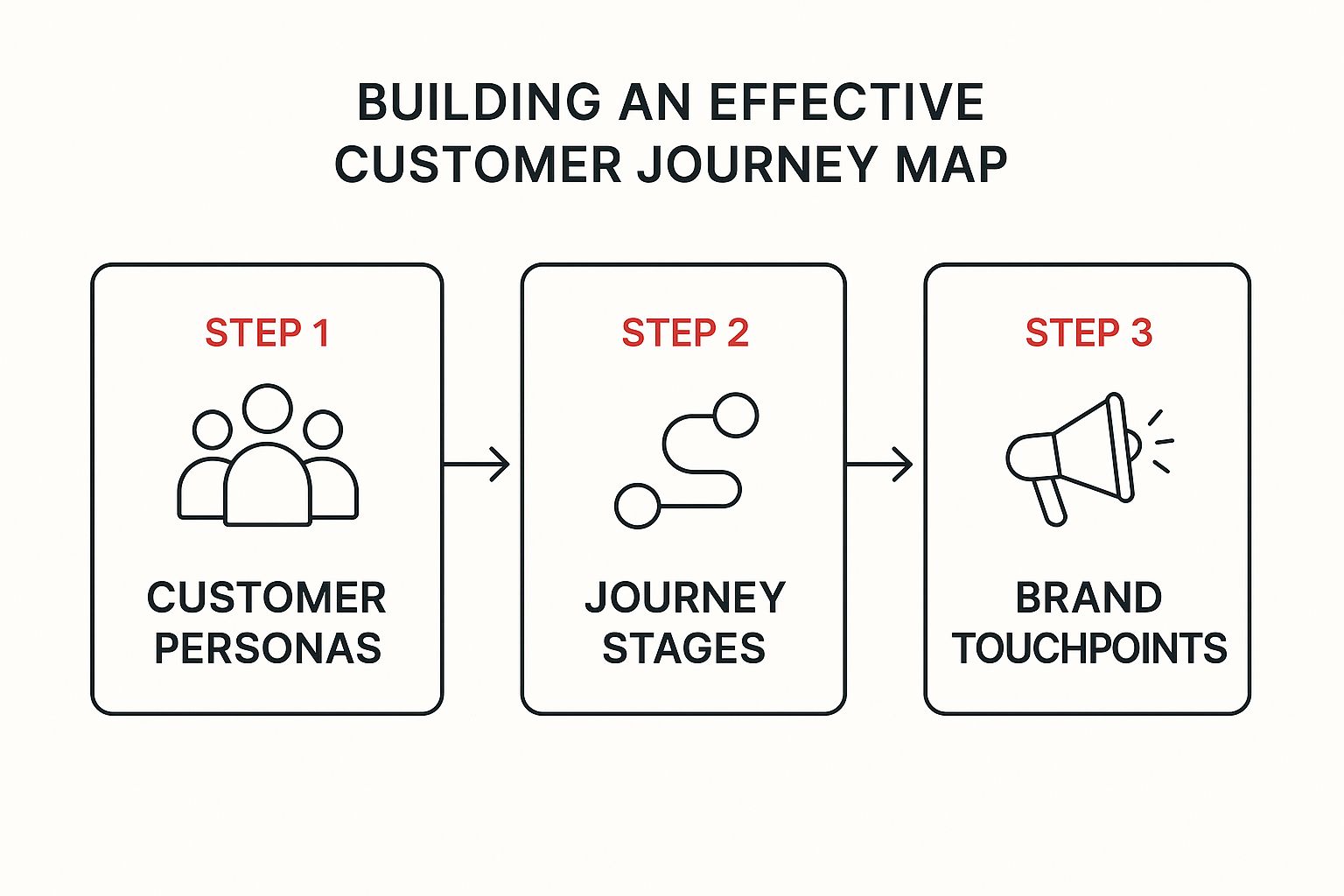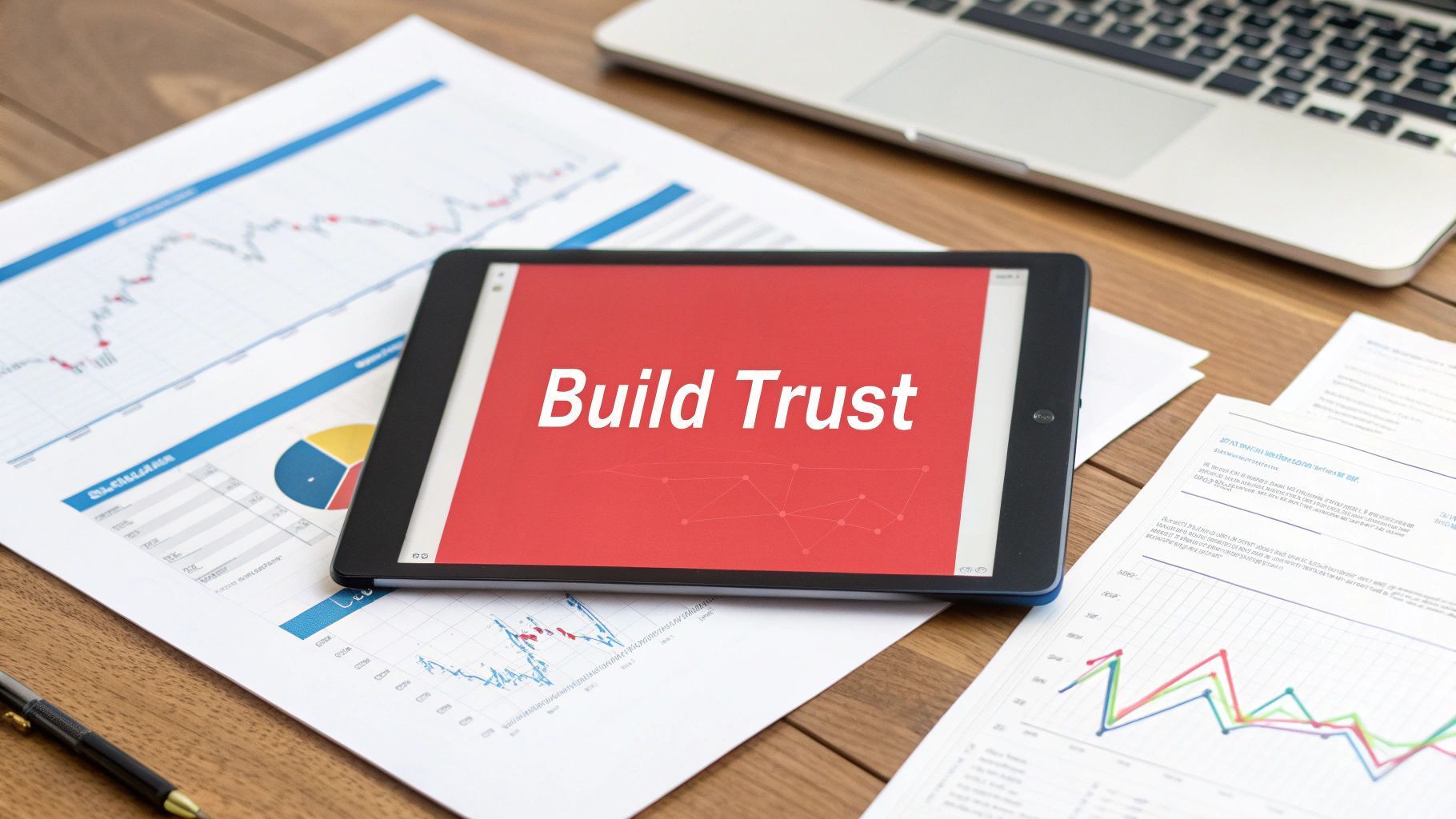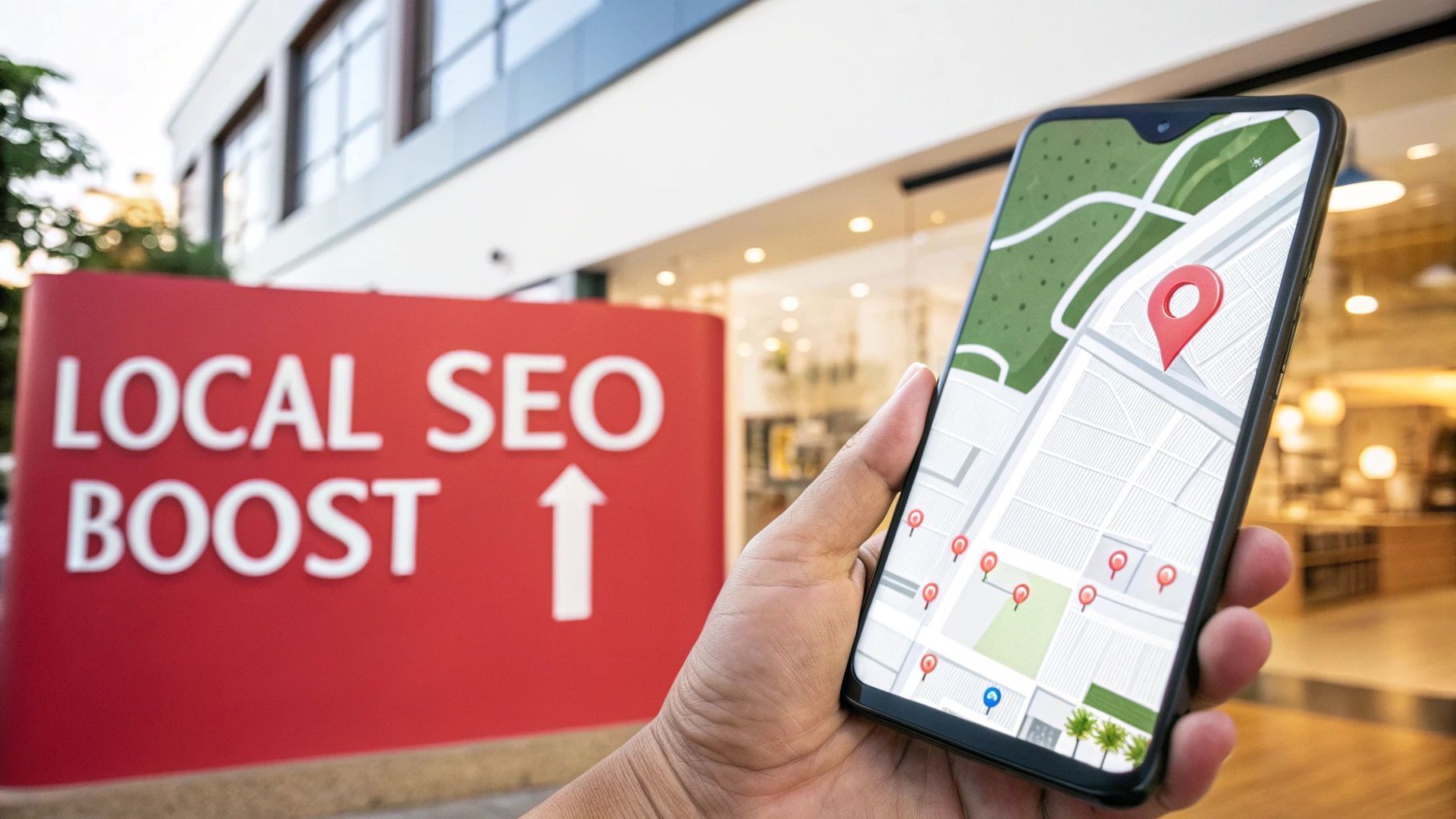What Is Customer Journey Mapping? Boost Your Customer Experience
Customer journey mapping is the art of creating a visual story of every single interaction someone has with your business. It follows their experience from the first moment they hear about your brand to the point they become a loyal advocate, capturing their thoughts, feelings and frustrations along the way.
What Exactly Is a Customer Journey Map?

It’s tempting to think of this as just another sales funnel but it’s so much more. A funnel shows the neat, linear path you want customers to follow. A journey map reveals the messy, winding road they actually take.
Think of it as a detailed storybook. It’s a powerful way to step directly into your customer’s shoes and see your entire business through their eyes, complete with all the detours and bumps in the road.
This visual story goes way beyond tracking clicks and conversions. Its real purpose is to uncover the human element behind the data by charting the emotional highs and lows a person experiences. It highlights that initial buzz of discovering a product they love, the quiet frustration of a confusing checkout or the relief of a genuinely helpful support chat.
Getting to the Core of It
At its heart, customer journey mapping is an exercise in empathy. It forces you to shift from an inward-looking, process-driven mindset to one that is completely focused on the customer.
This shift is critical for spotting 'pain points'—those specific moments where customers get stuck, become annoyed or just give up and leave. By pinpointing these issues, you can make targeted improvements that really matter.
Journey mapping is a cornerstone of the wider discipline of What is Customer Experience Management. It provides a clear, organised view that helps businesses achieve a few key things:
- Pinpoint Friction: Find the exact obstacles that are tripping your customers up.
- Understand Motivations: Uncover why people make certain decisions at each stage.
- Align Internal Teams: Get marketing, sales and support all on the same page with a shared, customer-first vision.
- Spot Opportunities: Discover new ways to add value and create moments of delight.
By visually laying out these interactions, you can stop making assumptions and start making informed, data-driven decisions that build real loyalty and fuel sustainable growth.
Why Journey Mapping Is a Business Necessity

It’s one thing to know what a customer journey map is but understanding why it’s so crucial is what unlocks its real value. This is far more than just a pretty diagram to stick on the wall; it's a strategic tool that has a direct impact on customer satisfaction, loyalty and even your own operational efficiency.
When you step into your customer's shoes and see your business from their perspective, you stop guessing and start knowing. This shift in viewpoint gives you the clarity to find and fix all those little friction points—the small but infuriating snags that make people abandon their shopping baskets or look for a competitor. Smooth those out and the entire experience becomes better.
This customer-first mindset has a powerful ripple effect internally, too. It gets everyone, from marketing and sales right through to customer support, aligned around a single, shared vision of the customer’s experience. That shared understanding breaks down the walls between departments, ensuring every interaction a customer has with you is consistent and helpful.
Uncovering Opportunities and Gaining an Edge
Beyond just fixing problems, journey mapping is fantastic for spotting hidden opportunities to innovate and grow. By charting every touchpoint, you can pinpoint moments where a small, thoughtful touch could turn a standard interaction into something truly memorable. These are the moments that build a real competitive advantage.
For UK brands in 2025, customer journey mapping isn't just a good idea—it's essential. As AI-driven personalisation and omnichannel experiences become the norm, a deep understanding of the customer's path is critical for building loyalty. For example, businesses dedicating up to 20% of their marketing budgets to journey analytics have reported major improvements in customer experience. In the UK’s fiercely competitive e-commerce space, this approach is what helps companies stand out.
In essence, journey mapping transforms abstract data into an actionable story. It allows your business to make smarter, evidence-based decisions that resonate deeply with your audience.
Driving Engagement and Loyalty
At the end of the day, business is about building relationships, not just processing transactions. A huge reason to map the journey is to create a smarter strategy for building genuine, lasting connections, which is why it's fundamental for mastering customer engagement plans.
When you understand what truly motivates your customers at each stage, you can deliver the right message at the right moment. This leads to more meaningful interactions and fosters a sense of loyalty that goes far beyond price. Our guide on the power of personalisation in digital marketing dives deeper into how this tailored approach can make all the difference. In today’s crowded market, that ability to connect on a human level is what really sets a brand apart.
The Building Blocks of an Effective Journey map
To build a journey map that actually works, you need a clear blueprint. Think of it like building a house – you wouldn't just start laying bricks at random. You need a solid foundation and a plan that details every single room and how they connect. A customer journey map is built the same way, from several core components that fit together to create a complete picture of your customer's experience.
This isn’t about guesswork; it’s about systematically gathering and organising specific pieces of information. Each building block serves a unique purpose, from understanding who your customers really are to pinpointing exactly where and how they interact with your brand.
By breaking down the map's anatomy, you create a structured framework that guides your efforts. This ensures you're collecting the right data and presenting it in a way that’s both meaningful and actionable for your entire team.
Developing Authentic Customer Personas
The entire map is built around a central character: the customer persona . This isn't just a vague demographic summary. It's a semi-fictional representation of your ideal customer, grounded in real data and research. A great persona has a name, goals, motivations and frustrations.
For example, a persona for a UK-based online fashion retailer might be "Sustainable Sarah," a 28-year-old who values ethical production and is willing to pay more for quality. Understanding Sarah's mindset is the very first step to mapping a journey that truly resonates with her. Without this, your map will lack that crucial human element.
The following infographic illustrates the key steps in building a journey map, starting with these foundational personas.

As the visual shows, once you’ve established your personas, the process flows logically into defining the stages of their journey and identifying all the brand touchpoints along the way.
Defining Journey Stages and Touchpoints
With your persona in place, the next step is to outline the key stages of their journey. These are the major phases a customer moves through and they typically include:
- Awareness: The moment Sarah first realises she needs a new dress or stumbles across your brand.
- Consideration: When she starts digging into her options, comparing your brand with your competitors.
- Purchase: The point where she makes a decision and clicks "buy".
- Retention: Her experience after the purchase, including using the product and any interactions with your support team.
- Advocacy: When she's so happy with her experience that she starts telling her friends about your brand.
Within each of these stages, you need to identify all the touchpoints —every single point of interaction between the customer and your business. A touchpoint could be anything from seeing a social media ad and visiting your website to receiving a delivery or contacting customer service.
Mapping these interactions is vital for understanding the full scope of the user experience. You can learn more about how these elements fit together by exploring our guide to master user experience design principles for better UX.
Ultimately, the goal is to map out not just what customers do at each touchpoint but also what they are thinking and feeling. Capturing these actions, thoughts and emotions is what transforms a simple flowchart into a powerful, empathetic tool for business improvement.
How to Create Your First Customer Journey Map
Putting together a customer journey map isn't some abstract creative exercise. It's a structured process that turns customer data into a clear, actionable story. The whole point is to methodically piece together your customer’s experience so you can finally see your business from their perspective.
This isn’t about guesswork or sitting in a boardroom making assumptions. It’s a hands-on approach that brings everyone together—from sales and marketing to the folks in customer support—to build a shared understanding of what your customers actually go through.
By following a few logical steps, you can build a map that delivers immediate insights and shows you exactly where to focus your efforts for the biggest impact.
Set Clear Objectives for Your Map
Before you even think about gathering data, you need to know why you’re building the map. A map without a clear goal is just a pretty picture; it has no direction and won't lead to any meaningful change.
Ask yourself what specific business problem you're trying to solve. Are you trying to figure out why so many people abandon their shopping baskets? Is your customer onboarding process confusing? Or do you simply want to know why no one is signing up for your newsletter?
Setting a clear, focused objective from the start ensures your efforts are tied directly to a business outcome. For example, a solid goal would be: "Identify and reduce friction points in our online checkout process to increase conversions by 10% ."
Gather Comprehensive Customer Research
With your objective locked in, it’s time to collect the right data. This is where you get inside your customers' heads and to do that properly, you need a mix of hard numbers and human stories.
Some of the most effective ways to do this include:
- Surveys and Feedback Forms: Go straight to the source. Ask your customers directly about their experiences, challenges and motivations at different stages.
- Customer Interviews: Nothing beats a one-on-one conversation for gaining deep, qualitative insights into what your customers are really thinking and feeling.
- Website and App Analytics: Use your analytics to track actual user behaviour. See where people are dropping off and understand the paths they take to get there.
- Social Media Listening: Monitor what people are saying about your brand online. It’s a great way to capture candid, unfiltered feedback and sentiment.
Combining what customers say with what they actually do is the key to creating a map that’s both accurate and empathetic.
A customer journey map should be rooted in reality, not internal assumptions. The best maps are built on a solid foundation of real customer data and direct feedback.
Bring It All Together Visually
Now for the final step: visualising the journey. This is where you take all your research—your personas, stages, touchpoints and insights—and lay it all out in a clear, logical format. This could be as simple as a whiteboard covered in sticky notes or a detailed digital chart made with specialised software.
The map should plot the customer's journey chronologically, detailing their actions, thoughts and emotions at each and every touchpoint. This visual story makes it incredibly easy for your entire team to understand the customer’s experience at a glance.
Once your map is complete, the real work begins. Analyse it to find the 'moments of truth'—those critical interactions that have the biggest impact on how a customer feels about your brand. Look for patterns in their pain points and identify the biggest opportunities for improvement. This is how your map becomes a powerful tool for driving real change.
Customer Journey Maps in Action Across the UK

Theory is one thing but seeing a customer journey map play out in the real world is where it all clicks. By walking through a couple of realistic scenarios, we can see exactly how mapping uncovers the challenges and opportunities that UK businesses face every day.
Let’s explore two very different examples—one for a product-based business and another for a service. Each one will show us specific touchpoints, where customers get stuck and the simple but powerful improvements that mapping can inspire.
Example 1: An Online Fashion Retailer
First up, let’s imagine Chloe, a shopper from Manchester. Her journey with a trendy online fashion brand starts where so many do these days: on social media.
- Awareness: Chloe is scrolling through Instagram when a targeted ad for a dress catches her eye. She clicks through to the product page, feeling a sense of excitement .
- Consideration: The website is slick and mobile-friendly and she quickly adds the dress to her basket. But then, a moment of hesitation . She can’t easily find the returns policy.
- Purchase: She decides to take a chance and completes the checkout. The confirmation email lands and her feeling shifts to anticipation .
- Post-Purchase: A few days later, the dress arrives but the fit isn’t quite right. Now she feels disappointment . This is the moment of truth. She heads back to the website to start a return and if that process is a nightmare, her frustration will cement a negative experience.
- The Opportunity: The map immediately flags a weak spot: the unclear returns info during the consideration stage. By making the returns policy crystal clear on every product page, the retailer could squash that purchase hesitation. It also shows that a smooth, hassle-free returns process is vital for turning a negative moment into a positive one and keeping Chloe as a loyal customer.
Example 2: A Local Taxi Firm
Now, let's switch gears and think about Ben, who needs a taxi back to his flat in Birmingham after a late meeting. He pulls out his phone and opens a local firm's app to book a ride.
His journey is a series of small but crucial moments: booking the taxi, waiting for it to show up, the ride itself and finally, paying. A map of this experience might show he feels impatient when the app’s car tracker is glitchy or reassured when the driver is friendly and the car is clean.
A major friction point could be a clunky in-app payment system, creating a flash of frustration right at the very end. For service businesses like taxi firms, journey mapping is essential for ironing out these interactions. Finding bottlenecks, like a booking delay or a payment glitch, allows the company to implement fixes that make the entire experience smoother.
In the UK, more and more service businesses are realising how powerful this is for boosting quality and loyalty. It’s no surprise that the market for mapping tools is expected to balloon from USD 16.8 billion in 2025 to USD 76.2 billion by 2035. If you want to dive deeper into how journey mapping is changing UK service businesses, you can find more insights on cabcallexperts.com.
The Future of Journey Mapping with AI
Technology is completely changing how we understand the customer journey and Artificial Intelligence (AI) is at the heart of it. The old way of doing things—static journey maps based on past data—is being replaced by dynamic, predictive models that learn and adapt in real time. AI is the engine making this possible.
AI-powered tools can now take on the enormous job of gathering and analysing data from countless different places at once. This means businesses can sift through social media comments, website clicks and support chat logs simultaneously. The result? A much richer, more accurate picture of the customer experience than we've ever had before.
From Looking Backwards to Predicting Forwards
Instead of just reacting to problems after they’ve already happened, AI gives us a way to get ahead of them. By spotting patterns in customer behaviour, machine learning can anticipate what a customer might do next, identify potential frustrations before they even surface and suggest the best way to keep them happy and engaged.
This lets us create truly living journey maps. They aren't just static documents anymore; they are live visualisations that update with every new customer interaction, giving you a completely current view of their experience.
The real game-changer with AI in journey mapping is its power to shift from historical analysis to real-time personalisation and future prediction. It allows you to create incredibly relevant experiences for every single customer.
For UK businesses, these developments are a huge opportunity. AI doesn't just help navigate subtle regional differences in customer behaviour; it also makes sure that any personalisation efforts stay compliant with strict data privacy laws like GDPR. And it's already proving its worth. By 2025, companies using AI-driven insights reported a 15% increase in their customer satisfaction scores. This is part of a much bigger trend of digital growth, which you can read more about on openpr.com's report on the customer journey mapping market.
At the end of the day, these tools make the whole process of understanding your customers more powerful and precise than ever. You can learn more about this by reading our guide on how artificial intelligence is revolutionising digital marketing . AI is no longer a distant concept; it's a practical tool you can use today to build smarter, more empathetic customer journey maps.
Your Customer Journey Mapping Questions, Answered
To wrap things up, let's tackle a couple of the practical questions that always come up when teams first start getting their hands dirty with customer journey maps.
How Often Should I Update My Journey Map?
Think of your journey map as a living, breathing document, not a one-and-done project. It needs to evolve as your customers and your business do.
A good rule of thumb is to give your maps a proper review at least once or twice a year. You should also revisit them anytime you roll out a major new product, service or marketing campaign. For example, if you suddenly see your checkout abandonment rate spike, that’s your cue to dive back into the map and figure out what’s gone wrong.
What Is the Difference Between a Customer Journey Map and a User Flow?
While they sound similar, they actually serve very different purposes. A user flow is technical and narrow. It’s all about the specific, click-by-click steps someone takes on your website or app to complete a single task, like creating an account.
A customer journey map , on the other hand, is strategic and holistic. It captures the entire end-to-end experience across every single touchpoint—both online and offline. Crucially, it also digs into the customer's emotions, thoughts and motivations along the way. The journey map gives you the bigger picture that a user flow simply can't.
A customer journey map focuses on the ‘why’ behind a customer's actions and feelings. A user flow just charts the ‘how’ of a specific interaction.
Ready to map your own customer journeys and drive meaningful business growth? The expert team at Superhub can help you turn customer insights into powerful, results-driven strategies. Discover how our digital marketing and business growth services can elevate your brand by visiting us at https://www.superhub.biz.





